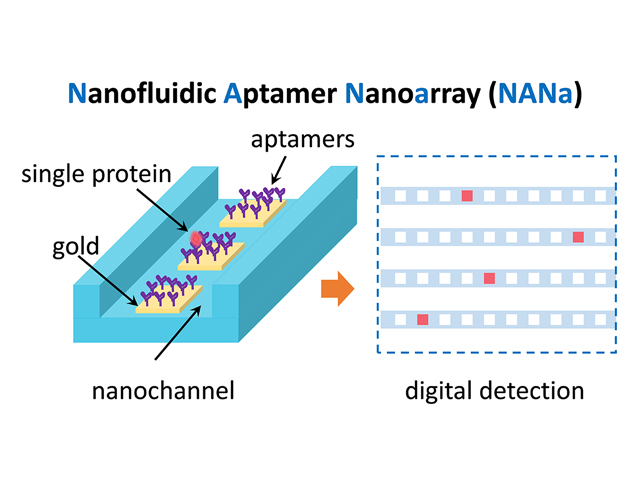Research News
Jun 23, 2023
- Engineering
Bridging the gap for precision medicine: nanofluidic aptamer nanoarray measures individual proteins
A pioneering step towards digital assays at cellular concentrations
Principle of Nanofluidic Aptamer Nanoarray (NANa)
Schematic illustration of the NANa principle for stochastically capturing and digitally detecting single proteins.
Credit: Yan Xu, Osaka Metropolitan University

In the evolving world of precision medicine, the need for methods that can measure biomolecules with supreme accuracy and specificity is paramount. Recognizing this, Associate Professor Yan Xu of the Graduate School of Engineering at Osaka Metropolitan University and his international research team, in collaboration with Professor Yong Wang of the Department of Biomedical Engineering at The Pennsylvania State University, have made a great stride in this direction. They have developed an innovative nanofluidic device capable of capturing single proteins stochastically and detecting them digitally at their naturally high concentrations. This breakthrough could potentially lay the foundation for the future of personalized disease prevention and treatment.
Precision medicine aims to tailor prevention and treatment strategies based on individual genetic data, environmental factors, lifestyle, and other determinants. Integral to this is the accurate measurement of biomolecules, such as genes and proteins, within single cells. However, until now, there have been no tools capable of simultaneously handling the minuscule volume of a single cell’s content—typically on the order of picoliters (10−12 L)—and quantifying biomolecules in high-concentration cellular environments.
The device, named the Nanofluidic Aptamer Nanoarray (or NANa for short), is a nanochannel-based chip designed for the digital assay of individual molecules in a sample with an ultrasmall volume equivalent to that of a single cell. Using synthetic antibodies known as aptamers, NANa can stochastically capture and digitally detect single molecules of target proteins even within high-concentration samples. These aptamers, which bind to specific molecules, are densely arrayed within the nanochannels of the device.
Looking forward, the researchers plan to conduct practical demonstrations with actual cell samples, digitize the measurement data obtained, and explore the potential of integrating AI-based image recognition technology and biological big data. “Humans are complex organisms consisting of a vast number of cells,” explained Professor Xu. “We hope NANa, which digitizes information on the number of biomolecules in individual cells, will serve as a bridge between life science and information science, paving the way for precision medicine in the future.”
The research results are set to be published in Small on June 23, 2023.
Funding
This study was partially supported by JSPS KAKENHI (Grant Nos. JP19KK0129, JP26706010, JP21H04640, JP20H00497, and JP21J14595), MEXT KAKENHI (Grant Nos. JP26107714, JP21H05231, and JP19H04678), JSPS Invitational Fellowships for Research in Japan (Grant No. S19151), JST PRESTO (Grant No. JPMJPR18H5) and JST CREST (Grant No. JPMJCR18H2).
Paper Information
Journal: Small
Title: Nanofluidic aptamer nanoarray to enable stochastic capture of single proteins at normal concentrations
DOI: 10.1002/smll.202301013
Author: Jinbin Yang, Hiroki Kamai, Yong Wang, Yan Xu
Publication date: June 23, 2023
https://doi.org/10.1002/smll.202301013
https://onlinelibrary.wiley.com/doi/10.1002/smll.202301013
Contact
Graduate School of Engineering
Yan Xu
E-mail: xuy[at]omu.ac.jp
*Please change [at] to @.
SDGs

